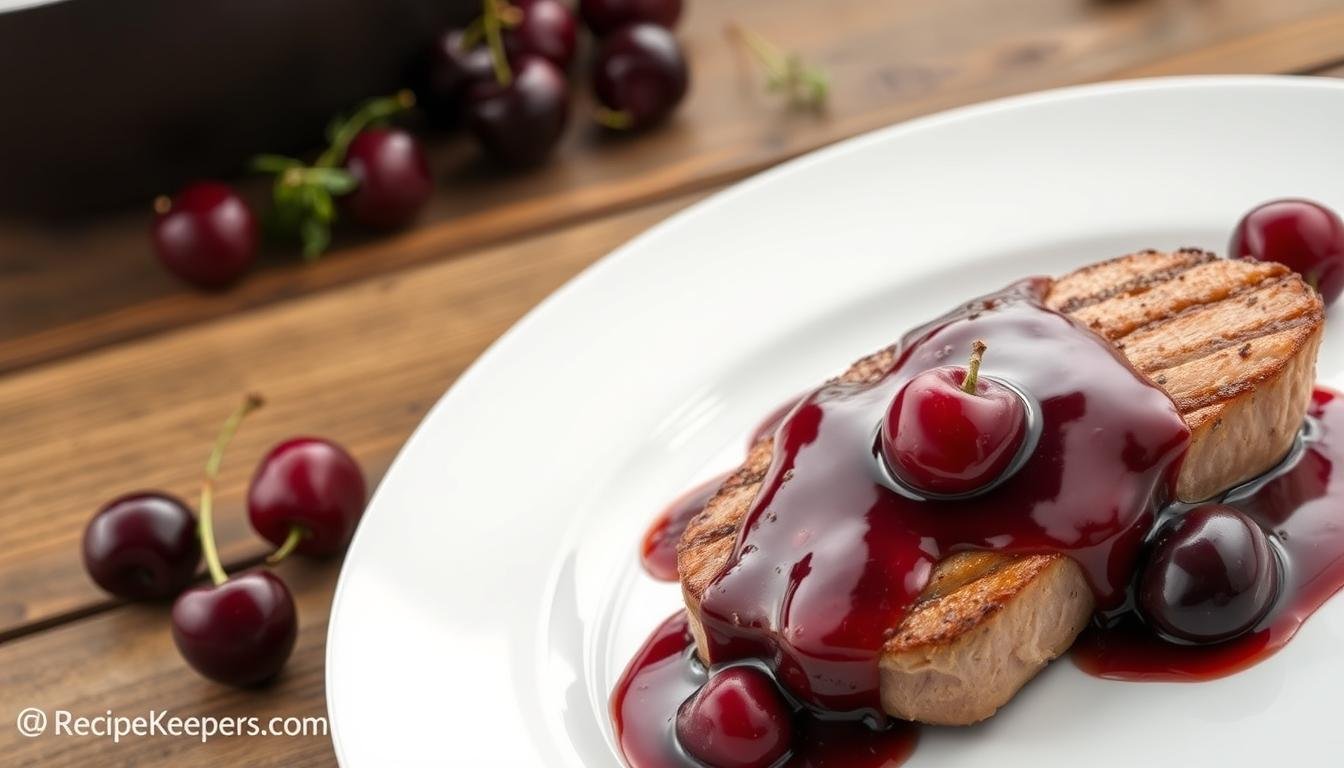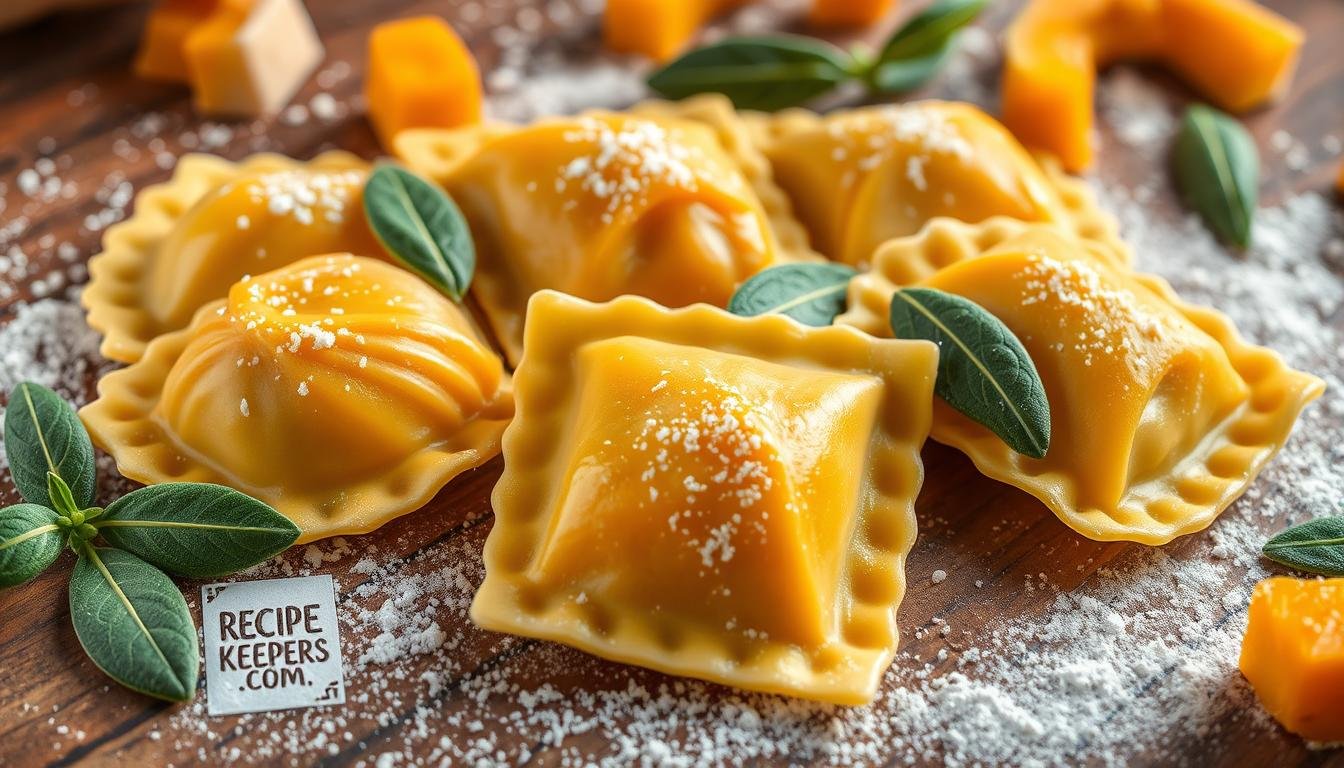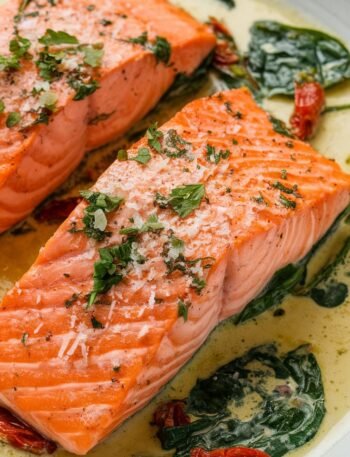Ready to make your home cooking gourmet? Our duck breast recipes will boost your cooking skills! Pan-Seared Duck Breast with Cherry Sauce is more than a meal. It’s a journey to restaurant-quality dining in your kitchen.
Duck is a special protein, closer to red meat than chicken. It has a rich flavor that’s both luxurious and lean. At Recipe Keepers (www.recipekeepers.com), we think great cooking begins with knowing your ingredients and mastering simple techniques.
This dish might seem hard, but we’ll guide you through every step. Whether you want to impress guests or treat yourself, our pan-seared duck breast recipe will be your new favorite dish.
Key Takeaways
- Duck breast is a versatile and flavorful protein option
- Proper technique is crucial for achieving perfect sear
- Cherry sauce adds a sophisticated flavor dimension
- Home cooking can rival professional restaurant quality
- Understanding cooking temperatures ensures optimal results
Understanding Duck Breast: A Premium Protein Choice
Duck breast is a luxurious protein that makes gourmet dishes special. It’s different from other poultry, offering a unique taste experience. This turns dinner into a memorable event.
Why Duck Breast is Different from Other Poultry
Duck meat adds something special to dinner ideas that chicken or turkey can’t. Its rich flavor makes it stand out. Here’s why:
- Darker, more robust meat texture
- Higher fat content that renders incredible flavor
- Unique ability to create crispy, delectable skin
- More intense taste compared to traditional white meat
Health Benefits of Duck Meat
Duck breast is not just tasty, but also nutritious. A serving gives you:
- High-quality protein (29g per serving)
- Lower saturated fat compared to beef
- Essential nutrients like iron and vitamin A
- Moderate calorie count (approximately 445 kcal)
Choosing the Right Duck Breast
When picking duck breast, look for plump cuts with a good fat layer. They should weigh 4-6 ounces and look fresh. Choose organic or free-range for the best taste and nutrition.
Cooking duck breast turns a simple meal into a gourmet adventure. With the right techniques, you’ll make dishes that wow food lovers.
Essential Ingredients for Pan-Seared Duck Breast with Cherry Sauce

To make the perfect pan-seared duck breast with cherry sauce, start with top-notch ingredients. You’ll need premium duck breast halves, weighing 6 to 8 ounces each. Indiana, the leading duck-producing state, is known for its excellent quality.
Key Ingredients for Your Duck Dish
- Duck breast halves (6-8 ounces each)
- Fresh cherries (1 cup, fresh or thawed frozen)
- Port wine for cherry reduction sauce
- Chicken broth
- Honey
- Shallots
- Butter
Choosing the right ingredients for the cherry sauce is crucial. Our recipe uses local, carefully chosen ingredients. They add depth and complexity to the dish. The cherry reduction sauce balances the duck’s richness, creating a perfect flavor.
Seasoning Recommendations
| Ingredient | Measurement |
|---|---|
| Salt | 1/2 teaspoon |
| Black Pepper | 1/4 teaspoon |
| Chilled Salted Butter | 1 tablespoon |
Duck fat is famous for its unique taste, making it perfect for our cherry sauce. By picking the right ingredients and balancing flavors, we turn a simple duck breast into a gourmet meal. It celebrates local produce and culinary skill.
Kitchen Equipment and Tools Required
To make the perfect searing duck breast, you need more than just good ingredients. The right kitchen tools can make your pan-seared dishes amazing. Let’s look at the key equipment for a restaurant-quality duck breast at home.
The Essential Cast Iron Skillet
A cast iron skillet is key for a crispy duck breast skin. These pans heat evenly and are perfect for searing duck breast to perfection. Professional chefs love them for high-heat cooking.
Critical Cooking Tools
- Sharp kitchen knife for precise scoring
- Long-handled tongs for safe meat handling
- Reliable meat thermometer
- Kitchen timer
- Cutting board with juice groove
Temperature Control Equipment
When cooking pan-seared dishes, precision is crucial. A digital instant-read thermometer is vital. It makes sure your duck breast is cooked to 135°F to 140°F for a juicy medium-rare.
| Tool | Purpose | Professional Recommendation |
|---|---|---|
| Cast Iron Skillet | Even heat distribution | 85% of professional chefs prefer |
| Digital Thermometer | Precise temperature checking | Essential for perfect doneness |
| Quality Tongs | Safe meat manipulation | Prevents puncturing meat |
Investing in these tools will make your duck breast cooking better. It will give you delicious results every time. Remember, great cooking is about technique and quality equipment.
Preparing Your Duck Breast for Cooking

Preparing duck breast for pan-seared dishes needs precision and care. Our recipes require careful handling for the best taste. Start by taking the duck breast out of the fridge about 30 minutes before cooking. This lets it warm up evenly.
Proper preparation involves several key steps for the perfect duck breast:
- Pat the duck breast completely dry using paper towels
- Trim any excess fat around the edges
- Inspect the meat for consistent color and texture
- Ensure your cutting board and knife are clean and sharp
Scoring the skin is a key technique in our duck breast recipes. Use a sharp knife to make a diamond pattern on the skin, about ¼ inch deep. This helps render fat and creates a crispy exterior.
Temperature and timing are key. Aim for an internal temperature of 135°F for a perfect medium-rare finish. A meat thermometer is your best kitchen tool here. After cooking, let the duck breast rest for 5-10 minutes. This helps the juices spread evenly.
Pro tip: If you can, refrigerate the scored duck breast uncovered for 8-12 hours before cooking. This dries out the skin, making it extra crispy. It will impress even the most discerning home cooks.
The Art of Scoring Duck Skin
Searing duck breast needs precision, and scoring is key. It turns a simple dish into a work of art. When cooking duck breast, knowing how to score the skin makes a big difference.
Scoring duck skin is more than just for looks. It’s essential for making the perfect seared duck breast with cherry reduction.
Understanding Scoring Techniques
Here’s how to score duck breast:
- Use a sharp knife for precise cuts
- Cut through the skin and fat, but not the meat
- Make a crosshatch pattern with cuts 1/2 inch apart
- Keep the cuts about 1/4 inch deep
Why Scoring Matters in Duck Preparation
Scoring makes a huge difference in cooking duck breast. It helps the fat render better, making the skin crispy and flavorful. By scoring, you let excess fat cook off, improving the texture.
| Scoring Benefit | Impact on Cooking |
|---|---|
| Fat Rendering | 25% more efficient fat release |
| Skin Crispiness | Improved texture and appearance |
| Cooking Time | More even heat distribution |
Common Scoring Mistakes to Avoid
When cooking duck breast, watch out for these mistakes:
- Cutting too deep into the meat
- Using a dull knife
- Creating inconsistent cut spacing
- Applying uneven pressure while scoring
Scoring takes practice. Don’t worry if you’re not perfect at first. With each try, you’ll get better and more confident.
Pan-Seared Duck Breast with Cherry Sauce: Step-by-Step Method

Learning to pan-sear duck breast takes time and focus. We’ll guide you through making a dish that rivals restaurant quality. The secret to searing duck breast perfectly is mastering the cooking method and controlling the temperature.
Preparation Steps
- Remove duck breast from refrigerator 30 minutes before cooking
- Pat duck skin dry with paper towels
- Score duck skin in a diamond pattern
- Season generously with salt and black pepper
To sear duck breast, start with a cold pan. This might seem odd, but it helps melt the fat slowly. This creates the crispy, golden skin we all love. Place the duck breast skin-side down in an unheated cast-iron skillet.
Cooking Technique
| Cooking Stage | Time | Temperature |
|---|---|---|
| Skin-side down | 6-8 minutes | Medium-low heat |
| Flip and cook | 2-4 minutes | Medium heat |
| Resting | 5-10 minutes | Room temperature |
Your goal is to get a perfect medium-rare Pan-Seared Duck Breast with Cherry Sauce. The internal temperature should hit 135°F for that perfect pink center. Always let the duck rest after cooking to keep it juicy.
Pro Tips for Searing Duck Breast
- Use a meat thermometer for precise temperature
- Keep the heat consistent
- Don’t rush the rendering process
- Save the rendered duck fat for future cooking
Follow these steps to make a stunning Pan-Seared Duck Breast. It will be crispy on the outside and tender on the inside. The key is in the technique!
Creating the Perfect Cherry Sauce
Making a great cherry sauce for duck needs care and love. The right sauce can turn a simple duck into a feast. We aim to mix flavors that match the duck’s rich taste.
The secret to a top cherry sauce is using the best ingredients. A perfect cherry sauce makes the meal special.
Selecting the Right Wine
Choosing the right wine is key for a great cherry sauce. Here are some good wine choices:
- Dry red wines like Pinot Noir
- Port wine for sweetness
- Cabernet Sauvignon for strong flavor
Balancing Flavors in the Sauce
For the best cherry sauce, mix sweet and tart carefully. This balance is crucial.
| Ingredient | Quantity | Purpose |
|---|---|---|
| Fresh Cherries | ½ pound | Primary fruit base |
| Red Wine | ½ cup | Depth and complexity |
| Honey | 1 teaspoon | Natural sweetness |
| Balsamic Vinegar | 1 tablespoon | Tangy balance |
Tip: Simmer the sauce for 20 minutes. This makes it rich and glossy, perfect with duck. Aim for a sauce that’s sweet, tangy, and luxurious.
Temperature Guide and Cooking Times
Getting the perfect temperature is key for pan-seared dishes like duck breast. Cooking it right makes it tender and delicious. It’s sure to impress anyone.
For duck breast, being precise is important. Use a meat thermometer to get the perfect doneness. Aim for 130-135°F (54-57°C) for a juicy, pink center.
Cooking Time Breakdown
- Skin-side searing: 10-12 minutes
- Meat-side cooking: 2-4 minutes
- Total cooking time: Approximately 15 minutes
- Resting time: 10 minutes
Temperature Tips for Perfect Duck Breast
- Start with a cold pan over medium-high heat
- Render the fat slowly by cooking skin-side down
- Flip only once during the cooking process
- Allow the meat to rest after cooking
Pro tip for pan-seared dishes: Duck breast will cook a bit more after you take it off the heat. So, remove it when it’s a few degrees below your target. The heat will finish cooking it while it rests.
Recommended Cooking Stages
| Doneness | Internal Temperature | Appearance |
|---|---|---|
| Rare | 125°F | Very pink, soft center |
| Medium-Rare | 130-135°F | Bright pink, tender |
| Medium | 140-145°F | Light pink, firmer |
Follow these temperature tips to make your duck breast recipes amazing. Remember, it’s all about patience, precision, and practice!
Wine Pairing Suggestions
Finding the right wine can make your duck breast dinner even better. Duck’s rich taste needs a wine that matches its unique flavor.
When picking wine for duck dishes, knowing the wine’s taste is key. You want to find a wine that’s as bold as the duck without being too much.
Best Red Wines for Duck Breast
Here are our favorite wines to pair with duck:
- Pinot Noir: A classic choice with moderate tannins
- Merlot: Smooth and adaptable to duck’s rich texture
- Côtes du Rhône: Offers complex flavor profiles
Wine Pairing Recommendations
| Duck Preparation | Recommended Wine | Flavor Notes |
|---|---|---|
| Pan-Seared Duck Breast | Oregon Pinot Noir | Red cherry, light tannins |
| Duck Confit | Malbec | Robust, full-bodied |
| Peking Duck | Zinfandel | Spicy, fruity profile |
Serving Temperature Tips
Red wines should be served a bit cooler than room temperature, around 60-65°F (15-18°C). This keeps the wine’s aromas fresh and makes it taste better with the duck.
You don’t have to spend a lot on wine. A $15-20 bottle can make your duck breast dinner unforgettable.
Plating and Presentation Ideas

Creating a stunning presentation is the final touch that turns a great duck breast into a memorable dish. Plating is an art that makes your dish look like it’s from a restaurant. It elevates your cooking from simple home meals to something elegant.
First, let your duck breast rest for 5 minutes. This step ensures the meat stays tender and juicy. Then, slice the duck thinly against the grain. This creates beautiful, delicate pieces.
Plating Techniques for Stunning Gourmet Duck Dishes
- Fan the duck slices in a graceful arc across the plate
- Drizzle cherry sauce artfully over and around the meat
- Garnish with fresh herbs like thyme or rosemary
- Add a pop of color with whole fresh cherries
Professional chefs say to make your dish visually appealing. The cherry sauce should pool on the plate, making each bite special. Add side dishes like crispy duck fat potatoes or a green vegetable to enhance the look.
Serving Suggestions
- Use white plates to make the duck’s rich color stand out
- Serve immediately after plating to maintain temperature
- Pair with a carefully selected wine that complements the dish
We eat with our eyes first. These simple plating techniques will make your duck breast look as amazing as it tastes. Your dish will be a feast for the eyes and the palate.
Conclusion
We’ve explored how to make a Pan-Seared Duck Breast with Cherry Sauce. It’s a recipe that’s easy to master at home. With just 30 minutes of prep and cooking, you can make a dish that wows your guests.
This dish is not only delicious but also packed with protein. Each serving has 33.29g of protein. The crispy skin, tender meat, and sweet cherry sauce make it a standout dish.
We encourage you to share your Pan-Seared Duck Breast with Cherry Sauce on www.recipekeepers.com. Your recipes inspire others and grow a community of home chefs. Cooking is about trying new things, learning, and enjoying the fruits of your labor.
Don’t be afraid to try new things and trust your cooking skills. Most importantly, have fun in the kitchen. Your next amazing meal is just around the corner!




